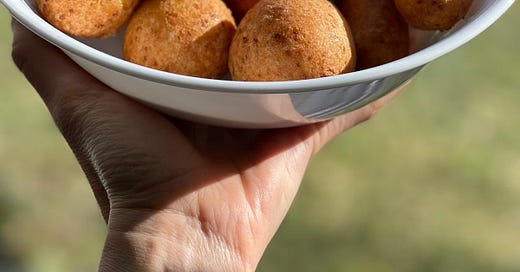ABOUT LATIN ROCK AND COLOMBIAN HOLIDAY FAVORITES: Buñuelos, Tamales Navideños, and Chocolate con Queso.
Collaboration by Lina Martínez
I grew up unaware of how extended the physical distance between México and most Latin American countries is, due to our elongated geography, and, as I watched Break it all this week on Netflix, I was reminded about how much that unawareness had to do with music. I could narrate the story of my life from adolescence into adulthood, starting with Soda Stéreo to Caifanes to Los Amigos Invisibles and Aterciopelados all the way to “La Avanzada Regia”. Reviving this music made me think of how far away so close we are as Latin Americans, about our beautiful and diverse cultures, but also, about our social and political struggles. And about tradition. This collaboration by Lina Martínez about Colombian Christmas food (in which she shares her family recipe for buñuelos) shows us how, although embellished with its particular regional elements, our most attached cultural rituals can be essentially the same —like Colombian “novenas de aguinaldo” and Mexican “posadas”, for example—, and how we also share a clear tendency to turn holidays into canonical fiestas.
*All of the buñuelos photos and videos are by Lina (@linita). I added a couple more traditional Colombian Christmas recipes (tamales & chocolate con queso) guided by her.
Previous collaborations by Lina Martínez: Vallecaucana Cuisine: Sancocho and Empanadas.
BUÑUELOS NAVIDEÑOS COLOMBIANOS
by Lina Martínez
Christmas in Colombia is, literally, a month-long party. The festivities start the 7th of December when the country is filled with candlelights —we call this “el día de las velitas” (or “the day of the candles”) but it’s the day of the Inmaculada Concepción— and it ends the 6th of January with the arrival of the Biblical Magi [in México, this eating and drinking marathon starts the 12th of December with the birthday of Tonatzin (“our mother” in Náhuatl) Guadalupe and ends in the same date, we call it “El Guadalupe-Reyes”].
Between the 16th and 24th of December, the “novena of bonuses” prayings are held. This is an essential activity for families not only because of the religious aspect of it but also because it marks the beginning of a non-stop feast of traditional foods. The nine prayings take place at nine different homes, and that means a different menu for each one. At the end of the prayers, we traditionally serve buñuelos, natilla, brevas, arequipe, hojaldras, and all kinds of amasijos.
In the home of my abuela Imelda, I didn’t have to wait until Christmas to eat buñuleos, though, every time I visited her they were there, I like to think that she made them for me because I was her favorite grandchild. Buñuelos are not commonly homemade you can get them at panaderías, but I’ve never tried buñuelos like my grandmother’s (or, honestly, like mine, because she taught me how to make them).
After the 24th of December and Christmas dinner, the Feria de Cali starts and everything becomes about drinking and dancing salsa till Newyear’s Eve (something as I’m not as attracted today as I once was since I had a pretty good share of it). The streets of Cali get closed down for the parades and comparsas to take the stage along with the famous “Salsadromo”. There are artists and live groups playing all over, in the street and in bars and nightclubs. The city doesn’t sleep. And when the holiday spirit comes to an end, what we have is a bunch of delicious leftover food to soothe el guayabo (or “the hangover”).
Keep reading with a 7-day free trial
Subscribe to Atole Newsletter to keep reading this post and get 7 days of free access to the full post archives.





